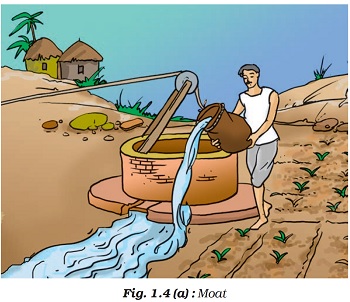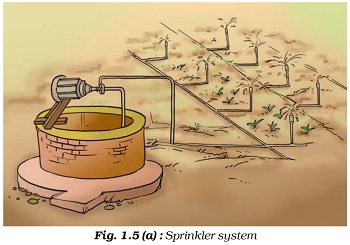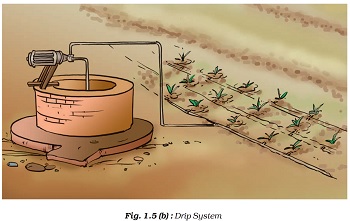1.6 Irrigation
NCERT Class 8 Science Textbook for Blind Students made Screen Readable by Dr T K Bansal.
All living beings need water to live. Water is important for proper growth and development. Water is absorbed by the plant roots. Along with water, minerals, and fertilizers are also absorbed. Plants contain nearly 90% water. Water is essential because germination of seeds does not take place under dry conditions. Nutrients dissolved in water are transported to each part of the plant. Water also protects the crop from both frost and hot air currents. To maintain the moisture of the soil for healthy crop growth, fields have to be watered regularly.
The supply of water to crops at regular intervals is called irrigation. The time and frequency of irrigation varies from crop to crop, soil to soil and season to season. In summer, the frequency of watering is higher. Why is it so? Could it be due to the increased rate of evaporation of water from the soil and the leaves?
I am very careful this year about watering the plants. Last summer my plants dried up and died.
Sources of irrigation :
The sources of water for irrigation are - wells, tubewells, ponds, lakes, rivers, dams and canals.
Traditional Methods of Irrigation:
The water available in wells, lakes and canals is lifted up by different methods in different regions, for taking it to the fields.
Cattle or human labour is used in these methods. So these methods are cheaper, but less efficient. The various traditional ways are:
(i) moat (pulley-system)
(ii) chain pump
(iii) dhekli, and
(iv) rahat (Lever system)
[Figs. 1.4 a, b, c, d.
Pumps are commonly used for lifting water. Diesel, biogas, electricity and solar energy is used to run these pumps.
Figure 1.4 (a) : Moat

Figure 1.4 (b) : Chain pump

Figure 1.4 (c) : Dhekli

Figure 1.4 (d) : Rahat

Modern Methods of Irrigation
Modern methods of irrigation help us to use water economically. The main methods used are as follows:
(i) Sprinkler System:
This system is more useful on the uneven land where sufficient water is not available. The perpendicular pipes, having rotating nozzles on top, are joined to the main pipeline at regular intervals. When water is allowed to flow through the main pipe under pressure with the help of a pump, it escapes from the rotating nozzles. It gets sprinkled on the crop as if it is raining. Sprinkler is very useful for lawns, coffee plantation and several other crops [Figure 1.5 (a)].
Figure 1.5 (a) : Sprinkler system

(ii) Drip system :
In this system, the water falls drop by drop directly near the roots. So it is called drip system. It is the best technique for watering fruit plants, gardens and trees [Figure 1.5(b)]. Water is not wasted at all. It is a boon in regions where availability of water is poor.
Figure 1.5 (b) : Drip System

